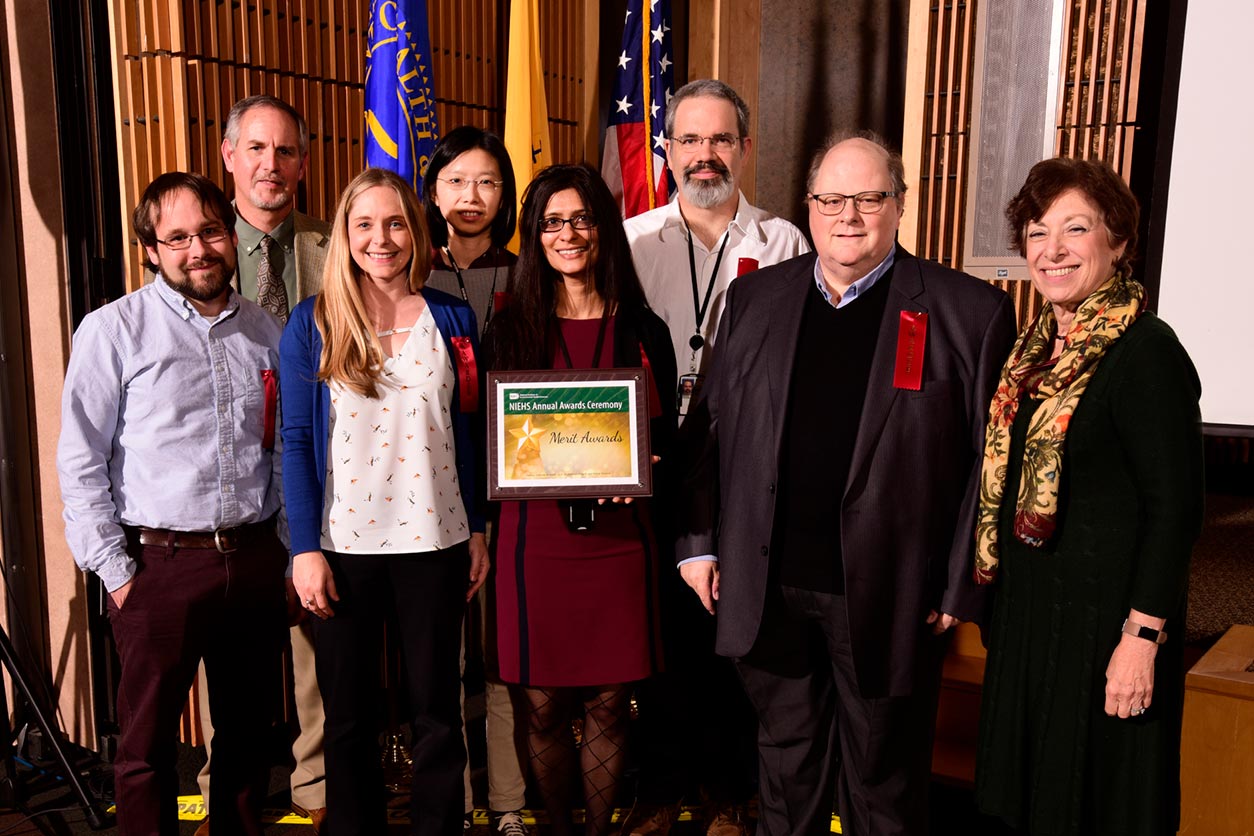The National Toxicology Program (NTP) evaluated a battery of cell-based and nontraditional animal models to predict the effects of various chemicals on development of the human neurological system. A collection of eight journal articles, published together in the January issue of Toxicological Sciences (see sidebar), described different aspects of the initiative.
“Over the past decade, there has been increased recognition of the need to develop more and better methods to rapidly identify compounds that have the potential for developmental neurotoxicology,” said Mamta Behl, Ph.D., from the NTP Toxicology Branch. Behl led the effort and is first author on the overview article and co-author of three companion articles in the journal collection.
 The freshwater zebrafish is widely used in developmental biology and toxicology studies. Their small size and rapid development allow study of how early life exposures influence normal body processes in later life.
The freshwater zebrafish is widely used in developmental biology and toxicology studies. Their small size and rapid development allow study of how early life exposures influence normal body processes in later life.“There is a pressing need to demonstrate the utility and limitations of these approaches so that they can be put into effect as soon as possible, especially in the context of prioritizing chemicals for further in-depth evaluation to help protect public health,” she added.
Filling the toxicity gap
 As a neurotoxicologist, Behl is responsible for developing testing strategies to assess developmental neurotoxicity and neurotoxicity using in vitro and in vivo models. (Photo courtesy of Steve McCaw)
As a neurotoxicologist, Behl is responsible for developing testing strategies to assess developmental neurotoxicity and neurotoxicity using in vitro and in vivo models. (Photo courtesy of Steve McCaw)Currently, tens of thousands of chemicals lack toxicity data. Once a compound is identified as potentially neurotoxic, it can take more than a decade to implement regulations, according to Behl. Resource and time limitations make it impossible to test all of these compounds using traditional rodent studies.
In light of the global rise in neurodevelopmental disorders, NTP hosted a collaborative project with approximately 40 participants from academia, industry, government, and regulatory agencies. The aim was to advance the development of a rapid and effective screening approach to prioritize compounds for traditional animal testing.
Same compounds, different tests
NTP provided participants with a compound library that consisted of known and suspected neurotoxicants. These compounds included drugs, flame retardants, industrial chemicals, polycyclic aromatic hydrocarbons, pesticides, and presumptive negative controls.
Separate groups of researchers tested these chemicals using their respective cell-based assays or alternative animal models, such as zebrafish. Each approach captured a unique aspect of neurodevelopment.
Data analysis innovation
NTP then developed a data analysis system so the data from the tests could be combined in a set that would improve biological coverage. “The critical contribution of the NTP collaboration is that this was the first time that a unified data analysis pipeline has been applied across a common set of characterized chemicals provided to each investigator,” Behl explained.
“The advantage of this approach is that the results from these assays can now be directly compared with each other,” said Richard Paules, Ph.D., acting head of the NTP Biomolecular Screening Branch. Such comparisons will help researchers to identify potential underlying brain development pathways that may be disturbed following chemical exposure.
Data from the studies are now publicly available through an interactive web application known as Developmental NeuroToxicity Data Integration and Visualization Enabling Resource (DNT-DIVER). This NTP tool enables researchers to analyze, to compare, and to visualize results across multiple assays.
In the overview article, the authors described the goals of this project, the NTP chemical library, the data analysis strategy, and the web application (see summary(https://factor.niehs.nih.gov/2019/1/papers/dir/#a1)). They also reviewed knowledge gaps that need to be addressed for this approach to be used in regulatory decision-making.
“We need to constantly challenge ourselves to improve our understanding of knowledge gaps to define the developmental neurotoxicology space more comprehensively,” Behl said. “But we strongly believe that, in the interim, [test] batteries such as these can be put into effect to provide useful information on hazard identification, prioritization, and regulatory decision-making for more timely protection of public health.”
“What set this effort apart was involvement from across the Division of NTP, including the Toxicology Branch, Biomolecular Screening Branch, and the Program Operations Branch,” said Nigel Walker, Ph.D., acting head of the Toxicology Branch.
 NTP Associate Director Brian Berridge, D.V.M., Ph.D., second row left, and NIEHS and NTP Director Linda Birnbaum, Ph.D., right, congratulated project participants, from left, Andrew Shapiro, Kristen Ryan, Ph.D.; Jui-Hua Hsieh, Ph.D.; Behl; Fred Parham, Ph.D.; and Brad Collins. Not shown is Elizabeth Maull, Ph.D. The group received a 2018 NIEHS Group Merit Award for the effort that kicked off with a 2017 workshop. (Photo courtesy of Steve McCaw)
NTP Associate Director Brian Berridge, D.V.M., Ph.D., second row left, and NIEHS and NTP Director Linda Birnbaum, Ph.D., right, congratulated project participants, from left, Andrew Shapiro, Kristen Ryan, Ph.D.; Jui-Hua Hsieh, Ph.D.; Behl; Fred Parham, Ph.D.; and Brad Collins. Not shown is Elizabeth Maull, Ph.D. The group received a 2018 NIEHS Group Merit Award for the effort that kicked off with a 2017 workshop. (Photo courtesy of Steve McCaw)Citations:
Ash PEA, Dhawan U, Boudeau S, Lei S, Carlomagno Y, Knobel M, Al Mohanna LFA, Boomhower SR, Newland MC, Sherr DH, Wolozin B. 2019. Heavy metal neurotoxicants induce ALS-linked TDP-43 pathology. Toxicol Sci 167(1):105–115.
Behl M, Ryan K, Hsieh JH, Parham F, Shapiro AJ, Collins BJ, Sipes NS, Birnbaum LS, Bucher JR, Foster PMD, Walker NJ. Paules RS, Tice RR. 2019. Screening for developmental neurotoxicity at the National Toxicology Program: The future is here. Toxicol Sci 167(1):6–14.
Collins FS, Gray GM, Bucher JR. 2008. Toxicology. Transforming environmental health protection. Science 319(5865): 906–907.
Dach K, Yaghoobi B, Schmuck MR, Carty DR, Morales KM, Lein PJ. 2019. Teratological and Behavioral screening of the National Toxicology Program 91-compound library in zebrafish (Danio rerio). Toxicol Sci 167(1):77–91.
Hagstrom D, Truong L, Zhang S, Tanguay R, Collins ES. 2019. Comparative analysis of zebrafish and planarian model systems for developmental neurotoxicity screens using an 87-compound library. Toxicol Sci 167(1):15–25.
Hsieh JH, Ryan K, Sedykh A, Lin JA, Shapiro AJ, Parham F, Behl M. 2019. Application of benchmark concentration (BMC) analysis on zebrafish data: a new perspective for quantifying toxicity in alternative animal models. Toxicol Sci 167(1):92–104.
Sachana M, Bal-Price A, Crofton KM, Bennekou SH, Shafer TJ, Behl M, Terron A. 2019. International regulatory and scientific effort for improved developmental neurotoxicity testing. Toxicol Sci 167(1):45–57.
Sirenko O, Parham F, Dea S, Sodhi N, Biesmans S, Mora-Castilla S, Ryan K, Behl M, Chandy G, Crittenden C, Vargas-Hurlston S, Guicherit O, Gordon R, Zanella F, Carromeu C. 2019. Functional and mechanistic neurotoxicity profiling using human iPSC-derived neural 3D cultures. Toxicol Sci 167(1):58–76.
Zhang S, Hagstrom D, Hayes P, Graham A, Collins ES. 2019. Multi-behavioral endpoint testing of an 87-chemical compound library in freshwater planarians. Toxicol Sci 167(1):26–44.
(Janelle Weaver, Ph.D., is a contract writer for the NIEHS Office of Communications and Public Liaison.)









